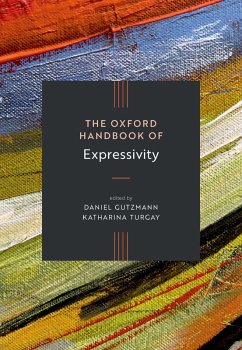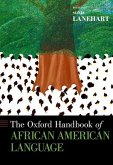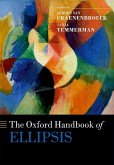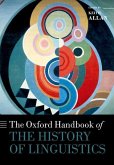- Gebundenes Buch
- Merkliste
- Auf die Merkliste
- Bewerten Bewerten
- Teilen
- Produkt teilen
- Produkterinnerung
- Produkterinnerung
This handbook offers a detailed and wide-ranging account of expressivity, the essential property that allows natural language to not just describe something in the world, but to directly express or display the speaker's attitudes or emotions. It provides critical surveys of existing research as well as new insights and innovative perspectives.
Andere Kunden interessierten sich auch für
![The Oxford Handbook of Archaeology and Language The Oxford Handbook of Archaeology and Language]() The Oxford Handbook of Archaeology and Language289,99 €
The Oxford Handbook of Archaeology and Language289,99 €![The Oxford Handbook of Rhetorical Studies The Oxford Handbook of Rhetorical Studies]() The Oxford Handbook of Rhetorical Studies210,99 €
The Oxford Handbook of Rhetorical Studies210,99 €![The Oxford Handbook of Ritual Language The Oxford Handbook of Ritual Language]() The Oxford Handbook of Ritual Language179,99 €
The Oxford Handbook of Ritual Language179,99 €![Oxford Handbook of African American Language Oxford Handbook of African American Language]() Oxford Handbook of African American Language239,99 €
Oxford Handbook of African American Language239,99 €![The Oxford Handbook of Translation and Social Practices The Oxford Handbook of Translation and Social Practices]() The Oxford Handbook of Translation and Social Practices200,99 €
The Oxford Handbook of Translation and Social Practices200,99 €![The Oxford Handbook of Ellipsis The Oxford Handbook of Ellipsis]() The Oxford Handbook of Ellipsis263,99 €
The Oxford Handbook of Ellipsis263,99 €![Oxford Handbook of the History of Linguistics Oxford Handbook of the History of Linguistics]() Oxford Handbook of the History of Linguistics205,99 €
Oxford Handbook of the History of Linguistics205,99 €-
-
-
This handbook offers a detailed and wide-ranging account of expressivity, the essential property that allows natural language to not just describe something in the world, but to directly express or display the speaker's attitudes or emotions. It provides critical surveys of existing research as well as new insights and innovative perspectives.
Produktdetails
- Produktdetails
- Verlag: Oxford University Press
- Seitenzahl: 1368
- Erscheinungstermin: 25. März 2026
- Englisch
- ISBN-13: 9780198869450
- ISBN-10: 0198869452
- Artikelnr.: 74361468
- Herstellerkennzeichnung
- Libri GmbH
- Europaallee 1
- 36244 Bad Hersfeld
- gpsr@libri.de
- Verlag: Oxford University Press
- Seitenzahl: 1368
- Erscheinungstermin: 25. März 2026
- Englisch
- ISBN-13: 9780198869450
- ISBN-10: 0198869452
- Artikelnr.: 74361468
- Herstellerkennzeichnung
- Libri GmbH
- Europaallee 1
- 36244 Bad Hersfeld
- gpsr@libri.de
Daniel Gutzmann is Professor of German Linguistics at Ruhr University Bochum. His research explores phenomena at the interface between semantics, pragmatics, and syntax and he is a leading expert on expressives. Alongside his two OUP monographs Use-Conditional Meaning (2015) and The Grammar of Expressivity (2019) he has also (co-)authored three textbooks and co-edited several volumes, including the five-volume Wiley Blackwell Companion to Semantics (Wiley, 2021). Katharina Turgay is Associate Professor of German Linguistics at Ruhr University Bochum. Her wide-ranging work explores syntax and morphology, pedagogical linguistics and language acquisition, and semantics and pragmatics. The main focus of her current research is the study of slurs, expressivity, and secondary meaning. Her publications include articles in a variety of journals, two monographs, a textbook, and, as co-editor with Daniel Gutzmann, Secondary Content (Brill, 2019).
* 1: Daniel Gutzmann and Katharina Turgay: Expressivity: An
introduction
* Part I. Background and foundations
* 2: Laurence R. Horn: Expressivity in early philosophy and philology
* 3: Thorsten Sander: Expressivity in modern philosophy of language
* 4: Robert E. Innis: Expressivity in semiotics
* 5: James Martin: Expressivity in rhetoric
* 6: Dorit Bar-On: Expressivity in and before language
* Part II. Linguistic domains
* 7: Michael Adams: Expressivity and the lexicon
* 8: Jeffrey P. Williams: Expressivity and morphology
* 9: Andrés Saab: Expressivity and syntax
* 10: Daniel Gutzmann: Expressivity and multidimensional semantics
* 11: Robert Henderson: Expressivity and dynamic semantics
* 12: Lukas Müller: Expressivity and semantic change
* 13: Maria Paola Tenchini and Aldo Frigerio: Expressivity and speech
acts
* 14: Manuel Padilla Cruz: Expressivity and relevance theory
* 15: Rita Finkbeiner: Expressivity and construction grammar
* 16: Konstanze Marx-Wischnowski: Expressivity and discourse analysis
* 17: Mariia Pronina, Ingo Feldhausen, and Pilar Prieto: Expressivity
and prosody
* 18: Shlomit Ritz Finkelstein and Lynne C. Nygaard: Expressivity and
neurolinguistics
* 19: Filippo Domaneschi and Camilo Rodriguez Ronderos: Expressivity
and psycholinguistics
* 20: Elizabeth Hanks, Niall Curry, Emily Sharp, Gavin Brookes, and
Tony McEnery: Expressivity and corpus linguistics
* 21: Tatjana Scheffler: Expressivity and computational linguistics
* Part III. Linguistic phenomena
* 22: Fabian Bross: Expressivity and adjectives
* 23: Katharina Turgay: Expressivity and slurs
* 24: Ulrike Stange-Hundsdörfer: Expressivity and interjections
* 25: David Y. Oshima: Expressivity and honorifics
* 26: Patrícia Amaral: Expressivity and pronouns
* 27: Gerhard Schaden: Expressivity and vocatives
* 28: Ulrike Stange-Hundsdörfer: Expressivity and intensifiers
* 29: Andreas Trotzke: Expressivity and information structure
* 30: Christopher Davis: Expressivity and sentence types
* 31: Ad Foolen: Expressivity and metaphor
* Part IV. Further applications
* 32: Ariana N. Mohammadi: Expressivity and bilingualism
* 33: Andreas Trotzke: Expressivity and pedagogical linguistics
* 34: Stefan Hinterwimmer: Expressivity and perspectivity
* 35: Cornelia Ebert and Sebastian Walter: Expressivity and gestures
* 36: Patrick G. Grosz: Expressivity and emojis
* 37: Andreas Osterroth: Expressivity and the media
* 38: Patrik. N. Juslin: Expressivity and music
* 39: Katharina Felka and Andreas Stokke: Expressivity and lying
* 40: Elyse Methven: Expressivity and law
* 41: Andreas Triantafyllopoulos and Björn Schuller: Expressivity and
speech synthesis
* Part V. Expressivity across languages
* 42: Daniel Gutzmann and Katharina Turgay: Expressivity in German
* 43: Pierre-Yves Modicom: Expressivity in French
* 44: Renato Miguel Basso and Luisandro Mendes de Souza: Expressivity
in Brazilian Portuguese
* 45: Andrés Saab: Expressivity in Spanish
* 46: Marwan Jarrah and Sukayna Ali: Expressivity in Arabic
* 47: Nora Boneh: Expressivity in Modern Hebrew
* 48: Qiongpeng Luo: Expressivity in Chinese
* 49: Osamu Sawada: Expressivity in Japanese
* 50: Rachel Sutton-Spence and Donna Jo Napoli: Expressivity in sign
languages
introduction
* Part I. Background and foundations
* 2: Laurence R. Horn: Expressivity in early philosophy and philology
* 3: Thorsten Sander: Expressivity in modern philosophy of language
* 4: Robert E. Innis: Expressivity in semiotics
* 5: James Martin: Expressivity in rhetoric
* 6: Dorit Bar-On: Expressivity in and before language
* Part II. Linguistic domains
* 7: Michael Adams: Expressivity and the lexicon
* 8: Jeffrey P. Williams: Expressivity and morphology
* 9: Andrés Saab: Expressivity and syntax
* 10: Daniel Gutzmann: Expressivity and multidimensional semantics
* 11: Robert Henderson: Expressivity and dynamic semantics
* 12: Lukas Müller: Expressivity and semantic change
* 13: Maria Paola Tenchini and Aldo Frigerio: Expressivity and speech
acts
* 14: Manuel Padilla Cruz: Expressivity and relevance theory
* 15: Rita Finkbeiner: Expressivity and construction grammar
* 16: Konstanze Marx-Wischnowski: Expressivity and discourse analysis
* 17: Mariia Pronina, Ingo Feldhausen, and Pilar Prieto: Expressivity
and prosody
* 18: Shlomit Ritz Finkelstein and Lynne C. Nygaard: Expressivity and
neurolinguistics
* 19: Filippo Domaneschi and Camilo Rodriguez Ronderos: Expressivity
and psycholinguistics
* 20: Elizabeth Hanks, Niall Curry, Emily Sharp, Gavin Brookes, and
Tony McEnery: Expressivity and corpus linguistics
* 21: Tatjana Scheffler: Expressivity and computational linguistics
* Part III. Linguistic phenomena
* 22: Fabian Bross: Expressivity and adjectives
* 23: Katharina Turgay: Expressivity and slurs
* 24: Ulrike Stange-Hundsdörfer: Expressivity and interjections
* 25: David Y. Oshima: Expressivity and honorifics
* 26: Patrícia Amaral: Expressivity and pronouns
* 27: Gerhard Schaden: Expressivity and vocatives
* 28: Ulrike Stange-Hundsdörfer: Expressivity and intensifiers
* 29: Andreas Trotzke: Expressivity and information structure
* 30: Christopher Davis: Expressivity and sentence types
* 31: Ad Foolen: Expressivity and metaphor
* Part IV. Further applications
* 32: Ariana N. Mohammadi: Expressivity and bilingualism
* 33: Andreas Trotzke: Expressivity and pedagogical linguistics
* 34: Stefan Hinterwimmer: Expressivity and perspectivity
* 35: Cornelia Ebert and Sebastian Walter: Expressivity and gestures
* 36: Patrick G. Grosz: Expressivity and emojis
* 37: Andreas Osterroth: Expressivity and the media
* 38: Patrik. N. Juslin: Expressivity and music
* 39: Katharina Felka and Andreas Stokke: Expressivity and lying
* 40: Elyse Methven: Expressivity and law
* 41: Andreas Triantafyllopoulos and Björn Schuller: Expressivity and
speech synthesis
* Part V. Expressivity across languages
* 42: Daniel Gutzmann and Katharina Turgay: Expressivity in German
* 43: Pierre-Yves Modicom: Expressivity in French
* 44: Renato Miguel Basso and Luisandro Mendes de Souza: Expressivity
in Brazilian Portuguese
* 45: Andrés Saab: Expressivity in Spanish
* 46: Marwan Jarrah and Sukayna Ali: Expressivity in Arabic
* 47: Nora Boneh: Expressivity in Modern Hebrew
* 48: Qiongpeng Luo: Expressivity in Chinese
* 49: Osamu Sawada: Expressivity in Japanese
* 50: Rachel Sutton-Spence and Donna Jo Napoli: Expressivity in sign
languages
* 1: Daniel Gutzmann and Katharina Turgay: Expressivity: An
introduction
* Part I. Background and foundations
* 2: Laurence R. Horn: Expressivity in early philosophy and philology
* 3: Thorsten Sander: Expressivity in modern philosophy of language
* 4: Robert E. Innis: Expressivity in semiotics
* 5: James Martin: Expressivity in rhetoric
* 6: Dorit Bar-On: Expressivity in and before language
* Part II. Linguistic domains
* 7: Michael Adams: Expressivity and the lexicon
* 8: Jeffrey P. Williams: Expressivity and morphology
* 9: Andrés Saab: Expressivity and syntax
* 10: Daniel Gutzmann: Expressivity and multidimensional semantics
* 11: Robert Henderson: Expressivity and dynamic semantics
* 12: Lukas Müller: Expressivity and semantic change
* 13: Maria Paola Tenchini and Aldo Frigerio: Expressivity and speech
acts
* 14: Manuel Padilla Cruz: Expressivity and relevance theory
* 15: Rita Finkbeiner: Expressivity and construction grammar
* 16: Konstanze Marx-Wischnowski: Expressivity and discourse analysis
* 17: Mariia Pronina, Ingo Feldhausen, and Pilar Prieto: Expressivity
and prosody
* 18: Shlomit Ritz Finkelstein and Lynne C. Nygaard: Expressivity and
neurolinguistics
* 19: Filippo Domaneschi and Camilo Rodriguez Ronderos: Expressivity
and psycholinguistics
* 20: Elizabeth Hanks, Niall Curry, Emily Sharp, Gavin Brookes, and
Tony McEnery: Expressivity and corpus linguistics
* 21: Tatjana Scheffler: Expressivity and computational linguistics
* Part III. Linguistic phenomena
* 22: Fabian Bross: Expressivity and adjectives
* 23: Katharina Turgay: Expressivity and slurs
* 24: Ulrike Stange-Hundsdörfer: Expressivity and interjections
* 25: David Y. Oshima: Expressivity and honorifics
* 26: Patrícia Amaral: Expressivity and pronouns
* 27: Gerhard Schaden: Expressivity and vocatives
* 28: Ulrike Stange-Hundsdörfer: Expressivity and intensifiers
* 29: Andreas Trotzke: Expressivity and information structure
* 30: Christopher Davis: Expressivity and sentence types
* 31: Ad Foolen: Expressivity and metaphor
* Part IV. Further applications
* 32: Ariana N. Mohammadi: Expressivity and bilingualism
* 33: Andreas Trotzke: Expressivity and pedagogical linguistics
* 34: Stefan Hinterwimmer: Expressivity and perspectivity
* 35: Cornelia Ebert and Sebastian Walter: Expressivity and gestures
* 36: Patrick G. Grosz: Expressivity and emojis
* 37: Andreas Osterroth: Expressivity and the media
* 38: Patrik. N. Juslin: Expressivity and music
* 39: Katharina Felka and Andreas Stokke: Expressivity and lying
* 40: Elyse Methven: Expressivity and law
* 41: Andreas Triantafyllopoulos and Björn Schuller: Expressivity and
speech synthesis
* Part V. Expressivity across languages
* 42: Daniel Gutzmann and Katharina Turgay: Expressivity in German
* 43: Pierre-Yves Modicom: Expressivity in French
* 44: Renato Miguel Basso and Luisandro Mendes de Souza: Expressivity
in Brazilian Portuguese
* 45: Andrés Saab: Expressivity in Spanish
* 46: Marwan Jarrah and Sukayna Ali: Expressivity in Arabic
* 47: Nora Boneh: Expressivity in Modern Hebrew
* 48: Qiongpeng Luo: Expressivity in Chinese
* 49: Osamu Sawada: Expressivity in Japanese
* 50: Rachel Sutton-Spence and Donna Jo Napoli: Expressivity in sign
languages
introduction
* Part I. Background and foundations
* 2: Laurence R. Horn: Expressivity in early philosophy and philology
* 3: Thorsten Sander: Expressivity in modern philosophy of language
* 4: Robert E. Innis: Expressivity in semiotics
* 5: James Martin: Expressivity in rhetoric
* 6: Dorit Bar-On: Expressivity in and before language
* Part II. Linguistic domains
* 7: Michael Adams: Expressivity and the lexicon
* 8: Jeffrey P. Williams: Expressivity and morphology
* 9: Andrés Saab: Expressivity and syntax
* 10: Daniel Gutzmann: Expressivity and multidimensional semantics
* 11: Robert Henderson: Expressivity and dynamic semantics
* 12: Lukas Müller: Expressivity and semantic change
* 13: Maria Paola Tenchini and Aldo Frigerio: Expressivity and speech
acts
* 14: Manuel Padilla Cruz: Expressivity and relevance theory
* 15: Rita Finkbeiner: Expressivity and construction grammar
* 16: Konstanze Marx-Wischnowski: Expressivity and discourse analysis
* 17: Mariia Pronina, Ingo Feldhausen, and Pilar Prieto: Expressivity
and prosody
* 18: Shlomit Ritz Finkelstein and Lynne C. Nygaard: Expressivity and
neurolinguistics
* 19: Filippo Domaneschi and Camilo Rodriguez Ronderos: Expressivity
and psycholinguistics
* 20: Elizabeth Hanks, Niall Curry, Emily Sharp, Gavin Brookes, and
Tony McEnery: Expressivity and corpus linguistics
* 21: Tatjana Scheffler: Expressivity and computational linguistics
* Part III. Linguistic phenomena
* 22: Fabian Bross: Expressivity and adjectives
* 23: Katharina Turgay: Expressivity and slurs
* 24: Ulrike Stange-Hundsdörfer: Expressivity and interjections
* 25: David Y. Oshima: Expressivity and honorifics
* 26: Patrícia Amaral: Expressivity and pronouns
* 27: Gerhard Schaden: Expressivity and vocatives
* 28: Ulrike Stange-Hundsdörfer: Expressivity and intensifiers
* 29: Andreas Trotzke: Expressivity and information structure
* 30: Christopher Davis: Expressivity and sentence types
* 31: Ad Foolen: Expressivity and metaphor
* Part IV. Further applications
* 32: Ariana N. Mohammadi: Expressivity and bilingualism
* 33: Andreas Trotzke: Expressivity and pedagogical linguistics
* 34: Stefan Hinterwimmer: Expressivity and perspectivity
* 35: Cornelia Ebert and Sebastian Walter: Expressivity and gestures
* 36: Patrick G. Grosz: Expressivity and emojis
* 37: Andreas Osterroth: Expressivity and the media
* 38: Patrik. N. Juslin: Expressivity and music
* 39: Katharina Felka and Andreas Stokke: Expressivity and lying
* 40: Elyse Methven: Expressivity and law
* 41: Andreas Triantafyllopoulos and Björn Schuller: Expressivity and
speech synthesis
* Part V. Expressivity across languages
* 42: Daniel Gutzmann and Katharina Turgay: Expressivity in German
* 43: Pierre-Yves Modicom: Expressivity in French
* 44: Renato Miguel Basso and Luisandro Mendes de Souza: Expressivity
in Brazilian Portuguese
* 45: Andrés Saab: Expressivity in Spanish
* 46: Marwan Jarrah and Sukayna Ali: Expressivity in Arabic
* 47: Nora Boneh: Expressivity in Modern Hebrew
* 48: Qiongpeng Luo: Expressivity in Chinese
* 49: Osamu Sawada: Expressivity in Japanese
* 50: Rachel Sutton-Spence and Donna Jo Napoli: Expressivity in sign
languages








